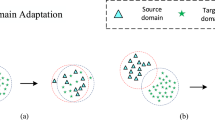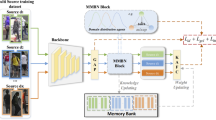Abstract
Most of existing unsupervised domain adaptation methods focus on aligning the feature discrepancy between labeled source and unlabeled target data. However, in practice, the source data may not be accessible due to transfer issue, privacy problem, etc. In such case, transferring knowledge through only the trained source model without the labeled source data remains a challenging problem. In this paper, we propose a novel method for source-free (without accessing any source domain data) multi-source domain adaptation in person re-identification (Re-ID). Two proxy tasks including proxy label learning and domain discriminative learning are designed to transfer knowledge from source models to the target domain with the inspiration of self-supervised learning. In the proxy label learning process, a subset of the unlabeled data in the target domain is randomly selected to trained a proxy label generator for measuring the similarity between each sample and the selected subset. With the proxy label as input, in the domain discriminative learning process, a domain discriminator is learnt to assign weights for measuring similarity between each source domain and the target one. With the combination of these two proxy tasks, knowledge from multiple source models can be properly aggregated and adaptively transferred to the target domain without any source data. Extensive evaluations on benchmark datasets, which are DukeMTMC and Market-1501, demonstrate the superior performance of the proposed method.





Similar content being viewed by others
Explore related subjects
Discover the latest articles, news and stories from top researchers in related subjects.References
Ahmed, S.M., Lejbolle, A.R., Panda, R., Roy-Chowdhury, A.K.: Camera on-boarding for person re-identification using hypothesis transfer learning. In: Proceedings of the IEEE/CVF Conference on Computer Vision and Pattern Recognition, pp. 12144–12153 (2020)
Bai, S., Li, Y., Zhou, Y., Li, Q., Torr, P.H.: Adversarial metric attack and defense for person re-identification. IEEE Trans. Pattern Anal. Mach. Intell. 43(6), 2219–2126 (2020)
Bojanowski, P., Joulin, A.: Unsupervised learning by predicting noise. In: ICML (2017)
Bousmalis, K., Silberman, N., Dohan, D., Erhan, D., Krishnan, D.: Unsupervised pixel-level domain adaptation with generative adversarial networks. In: CVPR (2017)
Chen, T., Ding, S., Xie, J., Yuan, Y., Chen, W., Yang, Y., Ren, Z., Wang, Z.: Abd-net: attentive but diverse person re-identification. In: ICCV (2019)
Deng, W., Zheng, L., Ye, Q., Kang, G., Yang, Y., Jiao, J.: Image-image domain adaptation with preserved self-similarity and domain-dissimilarity for person re-identification. In: CVPR (2018)
Ding, C., Wang, K., Wang, P., Tao, D.: Multi-task learning with coarse priors for robust part-aware person re-identification. IEEE Trans. Pattern Anal. Mach, Intell (2020)
Doersch, C., Gupta, A., Efros, A.A.: Unsupervised visual representation learning by context prediction. In: ICCV (2015)
Fan, H., Zheng, L., Yan, C., Yang, Y.: Unsupervised person re-identification: clustering and fine-tuning. In: TOMM (2018)
Fu, Y., Wei, Y., Wang, G., Zhou, X., Shi, H., Huang, T.S.: Self-similarity grouping: A simple unsupervised cross domain adaptation approach for person re-identification. In: ICCV (2018)
Fu, Y., Wei, Y., Wang, G., Zhou, Y., Shi, H., Huang, T.S.: Self-similarity grouping: a simple unsupervised cross domain adaptation approach for person re-identification. In: Proceedings of the IEEE/CVF International Conference on Computer Vision, pp. 6112–6121 (2019)
Ganin, Y., Ustinova, E., Ajakan, H., Germain, P., Larochelle, H., Laviolette, F., Marchand, M., Lempitsky, V.: Domain-adversarial training of neural networks. J. Mach. Learn. Res. 17(1), 2096–2031 (2017)
Gidaris, S., Singh, P., Komodakis, N.: Unsupervised representation learning by predicting image rotations. In: ICLR (2018)
He, K., Fan, H., Wu, Y., Xie, S., Girshick, R.: Momentum contrast for unsupervised visual representation learning. In: CVPR, pp. 9729–9738 (2020)
Hoffman, J., Tzeng, E., Park, T., Zhu, J., Isola, P., Saenko, K., Efros, A.A., Darrell, T.: Cycada: cycle-consistent adversarial domain adaptation. In: ICML (2018)
Larsson, G., Maire, M., Shakhnarovich, G.: Colorization as a proxy task for visual understanding. In: CVPR (2017)
Li, W., Zhao, R., Xiao, T., Wang, X.: Deepreid: deep filter pairing neural network for person re-identification. In: CVPR (2014)
Liao, S., Hu, Y., Zhu, X., Li, S.Z.: Person re-identification by local maximal occurrence representation and metric learning. In: CVPR (2015)
Lin, Y., Dong, X., Zheng, L., Yan, Y., Yang, Y.: A bottom-up clustering approach to unsupervised person re-identification. In: AAAI (2019)
Long, M., Cao, Y., Wang, J., Jordan, M.I.: Learning transferable features with deep adaptation networks. In: ICML (2015)
Long, M., Zhu, H., Wang, J., Jordan, M.I.: Deep transfer learning with joint adaptation networks. In: ICML (2017)
Luo, H., Gu, Y., Liao, X., Lai, S., Jiang, W.: Bag of tricks and a strong baseline for deep person re-identification. In: CVPRW (2019)
Lv, J., Chen, W., Li, Q., Yang, C.: Unsupervised cross-dataset person re-identification by transfer learning of spatial-temporal patterns. In: CVPR (2018)
Ma, N., Zhang, X., Zheng, H., Sun, J.: Shufflenet V2: practical guidelines for efficient CNN architecture design. In: ECCV (2018)
Noroozi, M., Favaro, P.: Unsupervised learning of visual representations by solving jigsaw puzzles. In: ECCV (2016)
Pathak, D., Krähenbühl, P., Donahue, J., Darrell, T., Efros, A.A.: Context encoders: feature learning by inpainting. In: CVPR (2016)
Peng, P., Xiang, T., Wang, Y., Pontil, M., Gong, S., Huang, T., Tian, Y.: Unsupervised cross-dataset transfer learning for person re-identification. In: CVPR (2016)
Peng, X., Bai, Q., Xia, X., Huang, Z., Saenko, K., Wang, B.: Moment matching for multi-source domain adaptation. In: ICCV (2019)
Qi, L., Wang, L., Huo, J., Zhou, L., Shi, Y., Gao, Y.: A novel unsupervised camera-aware domain adaptation framework for person re-identification. In: ICCV (2019)
Quionero-Candela, J., Sugiyama, M., Schwaighofer, A., Lawrence, N.: Dataset shift in machine learning. The MIT Press. ISBN 0262170051, 9780262170055 (2009)
Sandler, M., Howard, A.G., Zhu, M., Zhmoginov, A., Chen, L.: Mobilenetv2: inverted residuals and linear bottlenecks. In: CVPR (2018)
Song, G., Leng, B., Liu, Y., Hetang, C., Cai, S.: Region-based quality estimation network for large-scale person re-identification. In: AAAI (2018)
Song, L., Wang, C., Zhang, L., Du, B., Zhang, Q., Huang, C., Wang, X.: Unsupervised domain adaptive re-identification: theory and practice. Pattern Recogn. 102, 107173 (2020)
Sun, B., Saenko, K.: Deep CORAL: correlation alignment for deep domain adaptation. In: ECCVW (2016)
Sun, S., Shi, H., Wu, Y.: A survey of multi-source domain adaptation. Inf. Fusion. 24, 84–92 (2015)
Sun, Y., Zheng, L., Yang, Y., Tian, Q., Wang, S.: Beyond part models: person retrieval with refined part pooling (and A strong convolutional baseline). In: ECCV (2018)
Tzeng, E., Hoffman, J., Saenko, K., Darrell, T.: Adversarial discriminative domain adaptation. In: CVPR (2017)
Wang, J., Zhu, X., Gong, S., Li, W.: Transferable joint attribute-identity deep learning for unsupervised person re-identification. In: CVPR (2018)
Wang, J., Gao, Y., Li, K., Lin, Y., Ma, A.J., Sun, X.: Removing the background by adding the background: Towards background robust self-supervised video representation learning. In: CVPR (2021)
Wang, X., Liu, M., Raychaudhuri, D.S., Paul, S., Wang, Y., Roy-Chowdhury, A.K.: Learning person re-identification models from videos with weak supervision. IEEE Trans. Image Process. 30, 3017–3028 (2021)
Wang, X., Panda, R., Liu, M., Wang, Y., Roy-Chowdhury, A.K.: Exploiting global camera network constraints for unsupervised video person re-identification. IEEE Trans. Circuits Syst, Video Technol (2020)
Wei, L., Zhang, S., Gao, W., Tian, Q.: Person transfer GAN to bridge domain gap for person re-identification. In: CVPR (2018)
Wu, A., Zheng, W., Guo, X., Lai, J.: Distilled person re-identification: Towards a more scalable system. In: CVPR (2019)
Xu, R., Chen, Z., Zuo, W., Yan, J., Lin, L.: Deep cocktail network: multi-source unsupervised domain adaptation with category shift. In: CVPR (2018)
Yang, Q., Yu, H.X., Wu, A., Zheng, W.S.: Patch-based discriminative feature learning for unsupervised person re-identification. In: Proceedings of the IEEE/CVF Conference on Computer Vision and Pattern Recognition, pp. 3633–3642 (2019)
Yu, H., Wu, A., Zheng, W.: Cross-view asymmetric metric learning for unsupervised person re-identification. In: ICCV (2017)
Yu, H., Zheng, W., Wu, A., Guo, X., Gong, S., Lai, J.: Unsupervised person re-identification by soft multilabel learning. In: CVPR (2019)
Zhang, L., Qi, G., Wang, L., Luo, J.: AET vs. AED: unsupervised representation learning by auto-encoding transformations rather than data. In: CVPR (2019)
Zhang, R., Isola, P., Efros, A.A.: Colorful image colorization. In: ECCV (2016)
Zhao, H., Zhang, S., Wu, G., Moura, J.M.F., Costeira, J.P., Gordon, G.J.: Adversarial multiple source domain adaptation. In: NeurIPS (2018)
Zhao, S., Wang, G., Zhang, S., Gu, Y., Li, Y., Song, Z., Xu, P., Hu, R., Chai, H., Keutzer, K.: Multi-source distilling domain adaptation. In: AAAI (2020)
Zheng, L., Shen, L., Tian, L., Wang, S., Wang, J., Tian, Q.: Scalable person re-identification: a benchmark. In: ICCV (2015)
Zheng, L., Yang, Y., Hauptmann, A.G.: Person re-identification: Past, present and future. ArXiv preprint arXiv:1610.02984 (2016)
Zheng, Z., Yang, X., Yu, Z., Zheng, L., Yang, Y., Kautz, J.: Joint discriminative and generative learning for person re-identification. In: CVPR (2019)
Zheng, Z., Zheng, L., Yang, Y.: Unlabeled samples generated by GAN improve the person re-identification baseline in vitro. In: ICCV (2017)
Zhong, Z., Zheng, L., Li, S., Yang, Y.: Generalizing a person retrieval model hetero- and homogeneously. In: ECCV (2018)
Zhong, Z., Zheng, L., Luo, Z., Li, S., Yang, Y.: Invariance matters: exemplar memory for domain adaptive person re-identification. In: CVPR (2019)
Acknowledgements
This work was supported in part by the funding called Analyzing and hardening single event effects in LDO (2019A1515110127).
Funding
The funded was grant by Foshan University (2019A1515110127).
Author information
Authors and Affiliations
Corresponding author
Additional information
Publisher's Note
Springer Nature remains neutral with regard to jurisdictional claims in published maps and institutional affiliations.
Rights and permissions
About this article
Cite this article
Ding, Y., Duan, Z. & Li, S. Source-free unsupervised multi-source domain adaptation via proxy task for person re-identification. Vis Comput 38, 1871–1882 (2022). https://doi.org/10.1007/s00371-021-02246-8
Accepted:
Published:
Issue Date:
DOI: https://doi.org/10.1007/s00371-021-02246-8




